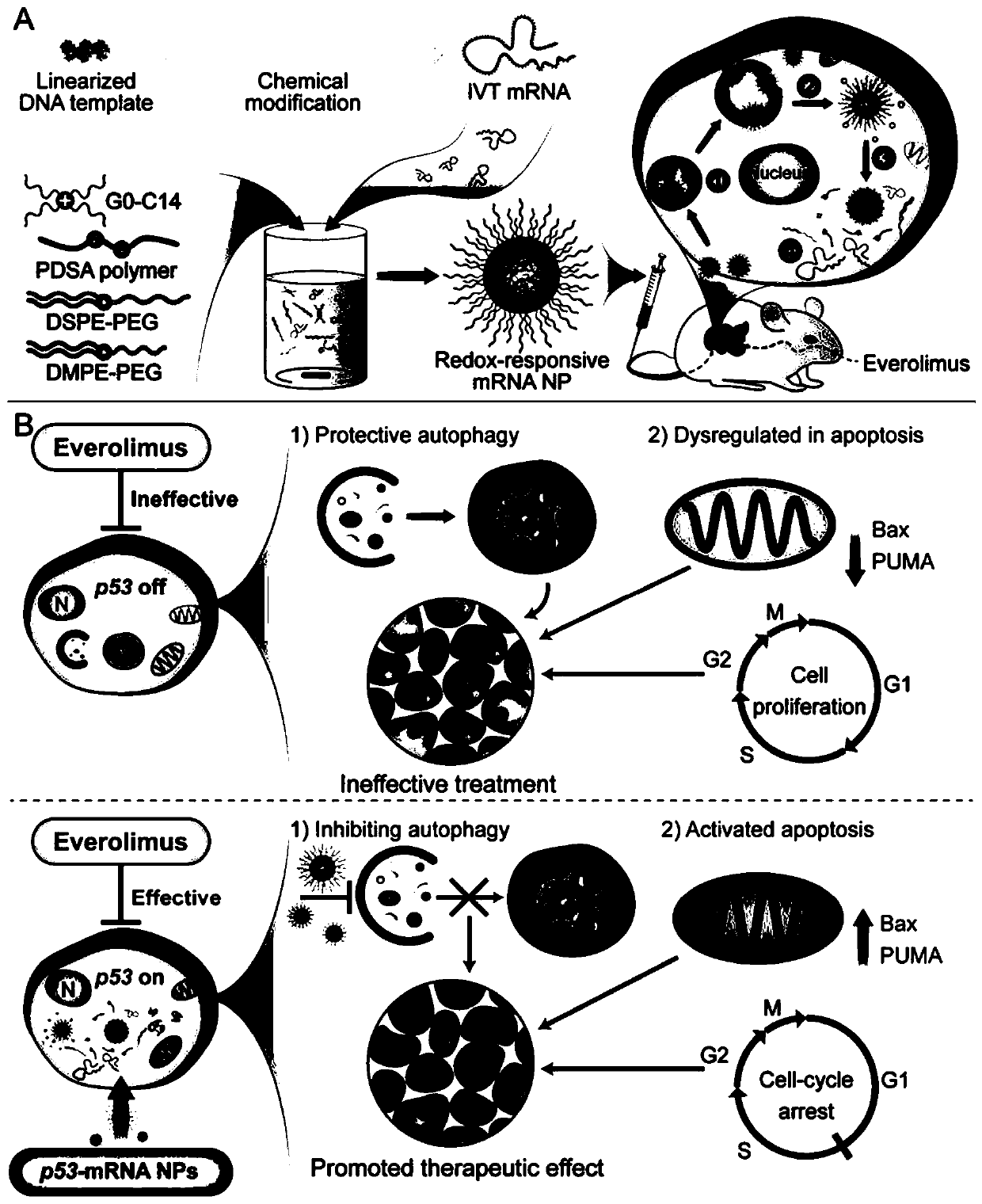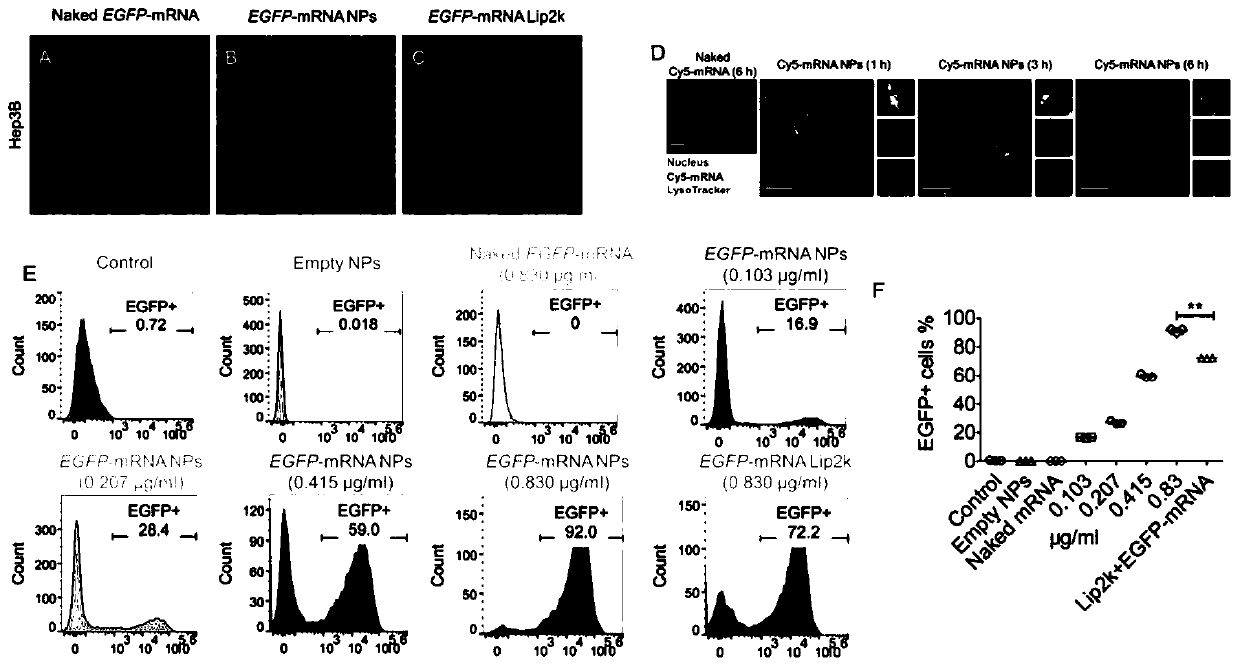P53 messenger RNA nanoparticles, preparation method thereof and application thereof in preparing drug for treating tumors
A technology of tumor drugs and nanoparticles, applied in DNA preparation, anti-tumor drugs, gene therapy, etc., can solve the problems of ineffective small molecule inhibitors, genome mutations, etc., and achieve the effect of enhancing chemotherapy sensitivity
- Summary
- Abstract
- Description
- Claims
- Application Information
AI Technical Summary
Problems solved by technology
Method used
Image
Examples
Embodiment 1
[0055] Example 1: Preparation of p53 messenger RNA nanoparticles:
[0056] 1. In vitro synthesis of chemically modified p53mRNA:
[0057] Use in vitro transcription technology (IVT) to synthesize enhanced green fluorescent protein (EGFP) and p53 messenger RNA (mRNA). An untranslated region (UTR) is designed at the 5'end of RNA to enhance the translation initiation of mRNA. In order to improve its stability and translation efficiency, a reverse cap analog (ARCR) was further applied to the 5'end of the mRNA. In order to avoid immune stimulation caused by mRNA, 5-methyl-cytidine triphosphate (5'-Methyl-CTP) and pseudouridine-5'-triphosphate (Pseudo-UTP) were used to replace conventional cytidine triphosphate and uridine Triphosphoric acid. The specific process is:
[0058] The human p53 gene open reading frame (ORF) plasmid carrying the T7 promoter was purchased from Addgene. Digest with HindIII / ApaI endonuclease to form linearized DNA. Then, the open reading frame of p53 contain...
experiment example 1
[0076] Experimental example 1: Nanocarriers deliver p53mRNA to restore the tumor suppressor function of p53 in hepatocellular carcinoma (Hep3B) and non-small cell lung cancer cells (H1299):
[0077] Experimental methods and steps:
[0078] 1. Immunofluorescence (IF) staining: Hep3B cells were fixed with 4% paraformaldehyde (Electron MicroscopySciences) for 15 minutes at room temperature, and then in 0.2% polyethylene glycol octyl phenyl ether (Triton X-100)-phosphate Soak in the buffer for 10 minutes. The samples were further incubated with phosphate blocking buffer solution (containing 2% bovine serum albumin, 2% normal goat serum and 0.2% gel) at room temperature for 30 minutes. Subsequently, it was fixed with 4% paraformaldehyde (Electron Microscopy Sciences) for 15 minutes. Incubate the first antibody overnight at 4°C, wash with phosphate buffer, and then mix with Alexa Fluor 647-labeled goat anti-mouse IgG (Molecular Probe Company) in blocking buffer (1:1000 dilution) at ro...
experiment example 2
[0084] Experimental example 2: p53 angioplasty enhances the sensitivity of p53-deficient hepatocellular carcinoma and non-small cell lung cancer cells to the mTOR inhibitor everolimus:
[0085] Experimental methods and steps:
[0086] 1. Cell survival experiment: p53-inactivated Hep3B or H1299 cells were evenly spread in a 96-well plate at a density of 5000 cells / well. After 24 hours of cell attachment, everolimus of different drug concentrations was added. After culturing for 24 hours, add 0.1ml fresh complete medium to continue culturing for 24 hours, and use Alarma Blue to detect cell viability.
[0087] 2. Western blotting: in dissolution buffer (1mM ethylenediaminetetraacetic acid, 20mM Tris HCl PH 7.6, 140mM sodium chloride, 1% aprotinin, 1% ethyl phenyl polyethylene glycol, 1 mM methyl sulfonate Lyse cells or tumor tissues in acid fluoride solution and 1mM sodium vanadate), and add protease inhibitors (Cell Signaling Technology). The protein concentration was detected by B...
PUM
 Login to View More
Login to View More Abstract
Description
Claims
Application Information
 Login to View More
Login to View More - R&D
- Intellectual Property
- Life Sciences
- Materials
- Tech Scout
- Unparalleled Data Quality
- Higher Quality Content
- 60% Fewer Hallucinations
Browse by: Latest US Patents, China's latest patents, Technical Efficacy Thesaurus, Application Domain, Technology Topic, Popular Technical Reports.
© 2025 PatSnap. All rights reserved.Legal|Privacy policy|Modern Slavery Act Transparency Statement|Sitemap|About US| Contact US: help@patsnap.com



